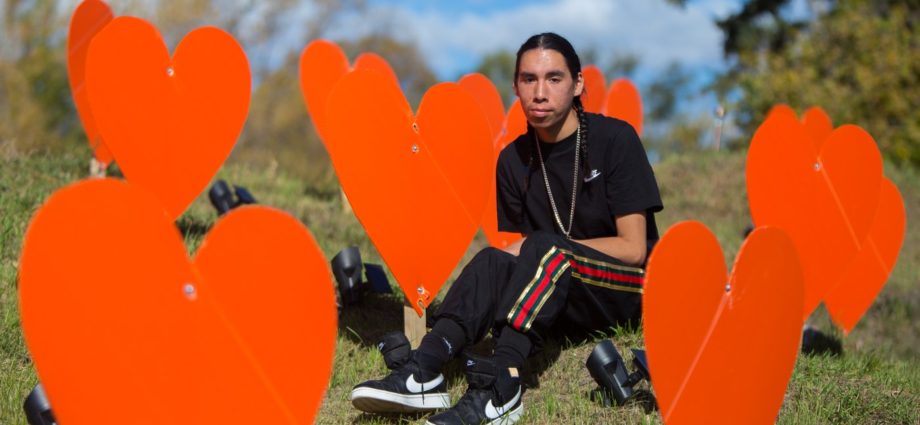
National Day for Truth and Reconciliation time for reflection, honesty
Sam Jackson visits the memorial for the 104 potential unmarked graves at the former Brandon Indian Residential School Monday, Sept. 20. (Chelsea Kemp/ The Brandon Sun)
By Chelsea Kemp, Local Journalism Initiative Reporter, Brandon Sun
September 30, 2021
Orange Shirt Day has taken on new meaning this year, with the federal government declaring Sept. 30 a National Day for Truth and Reconciliation.
Indigenous youth advocate Sam Jackson has spent years attending and speaking at different events spreading awareness about the long-term effects of residential schools.
It has been critically important to talk about residential schools in schools and at gatherings, he said, adding this year’s Orange Shirt Day is especially powerful in light of the thousands of unmarked graves located across the country in 2021.
It is heartbreaking visiting sites like the former Brandon Indian Residential School, he said. The orange hearts installed by the Southern Chiefs Organization each represent a child who was unable to go home. Jackson said he thinks about the children who never left the school and the survivors who made it home after experiencing unimaginable trauma and horrors.
“Every time I come here there is a connection — I’m heartbroken,” Jackson said. “It hurts because as a youth role model … watching children learn and watching children pick up something that has a lot of value to our people [is powerful]. How many children get to dig into their roots and find out who they are? These children didn’t.”
It is sad seeing the hearts representing the unmarked graves at the former Brandon Indian Residential School, but he is often overwhelmed knowing there are thousands more in Canada yet to be identified.
“I prayed for these kids. I prayed for our kids. I prayed for our friends and family. I couldn’t put names to words but I just prayed with everything that I had,” he said.
He hopes people will take time to stop and sit in reflection and honesty on the National Day for Truth and Reconciliation, so the country as a whole can work towards healing.
Jackson said his goal is to give youth in the community the opportunity to connect with their culture.
Jackson, 23, began powwow dancing eight years ago. He grew up in foster care and did not have the opportunity to see his biological family. He struggled to find his identity and never felt complete until he was able to connect with his culture as an Indigenous person.
He relates to the experience of being divorced from your culture when growing up.

“I grew up bullied. I grew up teased,” Jackson said. “Culture saved me and it continues to save me because without it I wouldn’t have a purpose right now.”
He learned how to dance by watching others and dedicated himself to becoming a gifted grass dancer.
He has now become a teacher so he can pass these teachings forward to other young people, leading with his heart, humility, compassion and kindness.
Jackson has attended a handful of powwows over the summer, and at each event, he would pray and dance for the victims of residential schools.
It is sad to think of the young people who attended residential school who never had the same opportunities:
“This year hits different,” Jackson said. “I feel the urgency to keep this going.”
He appreciates that the country is acknowledging this tragedy through the Day for Truth and Reconciliation. He added while Canadians cannot go back and change the tragedies of the past, they can work to build a better future.
He encouraged people to participate in Truth and Reconciliation events so they can better understand Indigenous cultures firsthand.
“Someone’s got to reach their hand out,” Jackson said. “Today matters the most. Don’t give up; there’s still life in you. Every breath that you take is a sign of life. There are people who care.”
Manitoba Metis Federation cultural youth worker Shannondoah Fleury said Sept. 30 plays an important role in helping raise awareness and recognition of the dark history of the residential school system.
“It’s a hard day for everybody. For me, I can see the community coming together to heal together, so it’s a good thing,” Fleury said.
She hopes to see people across Westman come together on what is a difficult day to help people heal. She explained that while people experience recovery from the trauma of residential schools individually, together community members can help support each other
Fleury said she plans on sitting and listening to stories on the Day for Truth and Reconciliation, spending time with her family and talking about residential schools.
“They’re pretty heartbreaking stories. It can be hard to hear for sure, but whatever our residential school survivors are willing to share, I think it’s important that there are people to listen to them,” Fleury said. “It’s hard and it’s part of the healing process.”
She can still see the effects of residential school today, Fleury said, and it can be a laborious and uncomfortable discussion learning about the institutions’ damaging legacy. Many contemporary problems stem from residential schools; people struggle to this day to recover from the trauma that has been passed down through generations.
“Our people are still healing. I think seeing things like Orange Shirt Day, seeing communities come together to listen and to be together and understand that it is a day of healing for everyone, not just Indigenous people,” Fleury said.
Subscribe to our newsletter.
For those new to Orange Shirt Day and truth and reconciliation, the key is to be respectful and come with an open heart, open mind and ready to listen:
“Don’t be scared to take part. It is healing for the entire community,” Fleury said. “We want to raise awareness and we want everybody to know the stories so things like this don’t ever happen again.”
» ckemp@brandonsun.com
» Twitter: @The_ChelseaKemp


